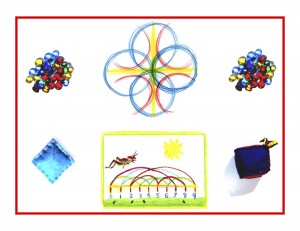Day 109
For one year, 365 days, this blog will address the Common Core Standards from the perspective of creating an alternate, ambient learning environment for math. Ambient is defined as “existing or present on all sides, an all-encompassing atmosphere.” And ambient music is defined as: “Quiet and relaxing with melodies that repeat many times.”
Why ambient? A math teaching style that’s whole and all encompassing, with themes that repeat many times through the years, is most likely to be effective and successful. Today’s standard will be listed in blue, followed by its ambient counterpart.
Measurement and Data 1.MD
Measure lengths indirectly and by iterating length units.
1. Order three objects by length; compare the lengths of two objects indirectly by using a third object.
Though measurement and time are not taught directly in the Waldorf school until Grade 3, foundational activities and lessons can pave the way for more formal learning. Here is an excerpt from Day 27 re the Common Core Kindergarten measurement standards:
As with many other elements, exposure to time and measurement will most likely happen way before third grade, but its formal introduction doesn’t happen till then. The reasoning is that the child crosses a significant boundary at age 9. Just as a readiness for learning becomes optimal at age 7, the first real steps out of the garden of childhood are taken two years later, at 9. Creation stories are told in third grade, as the child’s powers of reasoning develop alongside a beginning recognition of the realities of growing up.
As a thread that runs through most cultures’ creation stories, the expulsion from the garden is a theme that reflects this stage of development. Teaching practical things like housebuilding and farming / gardening are perfect at this time, because that’s how we collectively learned to live on the earth on our own, after leaving our respective gardens. Time and measurement fit this context nicely and for now, aspects of it can be shown and absorbed (rather than taught and learned) in a purely experiential and playful way.
I’m noticing after having gone back to the Kindergarten posts to find this, that the Kindy Common Core standards seem to be more creative and fun. It’s more challenging to come up with something for this standard. Let’s see. The most likely venues for practicing this would be the morning circle, nature studies, handwork, and form drawing. Taking these one by one,
Morning Circle:
Some wonderful movement exercises can be done with rods or dowels. To enhance a sense of the vertical and horizontal, the rod could be passed back and forth (rhythmically in time to a song or verse), first vertically then horizontally. Different length rods could be used for this exercise to address this standard, by exchanging them in succession while having the child measure each one against his or her own body. A special verse could be recited or sung along with this, something like:
This rod is wood, it came from a tree,
It’s little, it only reaches up to my knee.
This rod is smooth, it slides and slips,
It’s bigger, it reaches up to my hips.
And so on . . .
Nature Studies:
There are many opportunities for informal measurement on a walk in the woods or reviewing the treasures brought back from one. Specifically, a pine cone might be used to measure a foot print with, “How many pine cones long is your foot? How many is mine?” Or leaves and flower petals could be measured, “How many rose petals long is a maple leaf?”
Handwork:
Knitting needles could be measured with each other as they are cut, pointed, and sanded in preparation for a first knitting lesson. Cutting, measuring, and piecing patterns for simple sewing projects is another excellent opportunity to practice this standard.
Form Drawing:
Almost all straight-line form drawings offer opportunities to compare lengths. As an added element to the usual prep for form drawing (moving the form large by walking or running it) models could be used as well. Graduated-size straight sticks could be put together in their proper order before either moving or drawing the form. See below for a graduated lines form drawing.
As always, it’s the movement, story, and art that win the day with math! Knowledge ensues in an environment dedicated to imaginative, creative knowing, where student and teacher alike surrender to the ensuing of that knowledge as a worthy goal.













